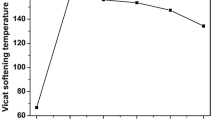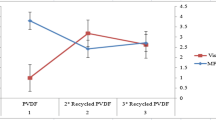Abstract
The recycled poly(vinyl chloride) (r-PVC) collected from the data cable has been incorporated into the recycled poly(methyl methacrylate) (r-PMMA) matrix in different weight percentage through the melt blending technique. The obtained recycled blends were analysed for mechanical, rheological, thermal and morphological characteristics. Among the various recycled blends formulated, 70:30 wt% of r-PVC/r-PMMA exhibits higher fracture toughness value. The rheological analysis highlights that recycled blends have pseudo-plastic characteristics. Furthermore, the storage and loss modulus values are decreasing with the increment of r-PVC in the recycled blend. The scanning electron microscope (SEM) study reveals the transformation of recycled blend matrix from brittle to the ductile character with the higher concentrations of r-PVC. Similarly, the water absorption, chemical resistance behaviour of the developed blends was depended on the concentration of r-PVC in the recycled blend.







Similar content being viewed by others
References
Kikuchi Y, Hirao M, Ookubo T, Sasaki A (2014) Design of recycling system for poly (methyl methacrylate)(PMMA). Part 1: recycling scenario analysis. Int J Life Cycle Assess. 19(1):120–129
Suresh SS, Mohanty S, Nayak SK (2017) Investigation into the mechanical and thermal properties of poly (methyl methacrylate) recovered from light guidance panels with a focus on future remanufacturing and sustainable waste management. J Remanufa 7(2):217–233
Popescu V, Vasile C, Brebu M, Popescu GL, Moldovan M, Prejmerean C, Stanulet L, Trişcă-Rusu C, Cojocaru I (2009) The characterization of recycled PMMA. J Alloys Compos 483(1):432–436
Suresh SS, Mohanty S, Nayak SK (2017) Bio-based epoxidised oil for compatibilization and value addition of poly (vinyl chloride)(PVC) and poly (methyl methacrylate)(PMMA) in recycled blend. J Polym Res 24(8):120–134
Kočevar G, Kržan A (2018) Recycling of an acrylate–glass fiber reinforced polyester composite. J Mater Cycl Waste Manag 20(2):1106–1114
Van Kasteren JMN, Slapak MJP (2001) The influence of additives on the steam gasification of PVC waste. J Mater Cycl Waste Manag 3(2):114–117
Saeki S, Kano J, Saito F, Shimme K, Masuda S, Inoue T (2001) Effect of additives on dechlorination of PVC by mechanochemical treatment. J Mat Cycl Waste Manag 3(1):20–23
Tawancy HM, Hassan M (2016) On the degradation mechanism of low-voltage underground cable with poly (vinyl chloride) insulation. J Mater Eng Perform 25(6):2288–2295
Brebu M, Vasile C, Antonie SR, Chiriac M, Precup M, Yang J, Roy C (2000) Study of the natural ageing of PVC insulation for electrical cables. Polym Degrad Stab 67(2):209–221
Suresh SS, Bonda S, Mohanty S, Nayak SK (2018) A review on computer waste with its special insight to toxic elements, segregation and recycling techniques. Process Saf Environ Protoc 116:477–493
Yu J, Sun L, Ma C, Qiao Y, Yao H (2016) Thermal degradation of PVC: a review. Waste Manag 48:300–314
Suresh SS, Mohanty S, Nayak SK (2017) Composition analysis and characterization of waste polyvinyl chloride (PVC) recovered from data cables. Waste Manag 60:100–111
Buekens A, Sevenster A (2010) Vinyl 2010—nearing the target date. J Mat Cycl Waste Manag 12(2):184–192
Gohatre OK, Jaidev K, Suresh SS, Biswal M, Mohanty S, Nayak SK (2019) Composition and recyclability analysis of poly (vinyl chloride) recovered from computer power cables and commercial wires. J Vinyl Addict Tech. https://doi.org/10.1002/vnl.21734
Sevenster A (2012) VinylPlus, the new European PVC industry’s voluntary programme toward sustainability. J Mat Cycl Waste Manag 14(4):281–285
Yoshihara M, Grause G, Kameda T, Yoshioka T (2010) Upgrading of poly (vinyl chloride) by chemical modifications using sodium sulfide. J Mater Cycl Waste Manag 12(3):264–270
Buekens A, Cen K (2011) Waste incineration, PVC, and dioxins. J Mat Cycl Waste Manage. 13(3):190–197
Ceran ÖB, Şimşek B, Uygunoğlu T, Şara ON (2019) PVC concrete composites: comparative study with other polymer concrete in terms of mechanical, thermal and electrical properties. J Mater Cycl Waste Manag. 1–11.
Anandhan S, Bhowmick AK (2013) Thermoplastic vulcanizates from post-consumer computer plastics/nitrile rubber blends by dynamic vulcanization. J Mat Cycl Waste Manag 15(3):300–309
Suresh SS, Mohanty S, Nayak SK (2019) Effect of nitrile rubber on mechanical, thermal, rheological and flammability properties of recycled blend. Process Saf Environ Protoc. 123:370–378
Buekens A, Yang J (2014) Recycling of WEEE plastics: a review. J Mater Cycl Waste Manag. 16(3):415–434
Khan MS, Qazi RA, Wahid MS (2008) Miscibility studies of PVC/PMMA and PS/PMMA blends by dilute solution viscometry and FTIR. Afr J Pure Appl Chem 2(4):041–045
Belhaneche-Bensemra N, Bedda A, Belaabed B (2003) Study of the properties of rigid and plasticized PVC/PMMA blends. Macromol Symp. 202(1):151–166.
Vorenkamp EJ, Ten Brinke G, Meijer JG, Jager H, Challa G (1985) Influence of the tacticity of poly (methyl methacrylate) on the miscibility with poly (vinyl chloride). Polym. 26(11):1725–1732
Aouachria K, Belhaneche-Bensemra N (2006) Miscibility of PVC/PMMA blends by vicat softening temperature, viscometry, DSC and FTIR analysis. Polym Test 25(8):1101–1108
Al-Sagheer F, Ahmad Z (2014) Stabilizing poly (vinyl chloride) using its blends with poly (methyl methacarylate): pyrolysis GC/MS studies. J Hazard Mat. 278:584–591
Suresh SS, Mohanty S, Nayak SK (2018) Synthesis and application of functionalised acrylonitrile–butadiene rubber for enhancing recyclability of poly (vinylchloride) (PVC) and poly (methylmethacrylate)(PMMA) in recycled blends. Clean Tech Environ Pol. 20(5):969–979
Sudha GS, Kalita H, Mohanty S, Nayak SK (2017) Biobased epoxy blends from epoxidized castor oil: effect on mechanical, thermal, and morphological properties. Macromol Res. 25(5):420–430
Kumar S, Samal SK, Mohanty S, Nayak SK (2017) Epoxidized soybean oil-based epoxy blend cured with anhydride-based cross-linker: thermal and mechanical characterization. Ind Eng Chem Res 56(3):687–698
Gotham KV, Scrutton IN (1978) Effect of molecular orientation on the fracture toughness of thermoplastics. Polymer 19(3):341–347
Wu S (1990) Chain structure, phase morphology, and toughness relationships in polymers and blends. Polym Eng Sci. 30(13):753–761
Zhang Z, Chen S, Zhang J (2013) Blends of poly (vinyl chloride) with α-methylstyrene-acrylonitrile-butadiene–styrene copolymer: Thermal properties, mechanical properties, and morphology. J Vinyl Addi Tech. 19(1):1–10
Zhou C, Si QB, Ao YH, Tan ZY, Sun SL, Zhang MY, Zhang HX (2007) Effect of matrix composition on the fracture behavior of rubber-modified PMMA/PVC blends. Polym Bullet. 58(5):979–988
Balakrishnan S, Neelakantan NR, Saheb DN, Jog JP (1998) Rheological and morphological behaviour of blends of polycarbonate with unmodified and maleic anhydride grafted ABS. Polym 39(23):5765–5771
Suresh SS, Mohanty S, Nayak SK (2017) Preparation and characterization of recycled blends using poly (vinyl chloride) and poly (methyl methacrylate) recovered from waste electrical and electronic equipments. J Clean Prod. 149:863–873
Perera MCS, Ishiaku US, Ishak ZAM (2000) Thermal degradation of PVC/NBR and PVC/ENR50 binary blends and PVC/ENR50/NBR ternary blends studied by DMA and solid state NMR. Polym Degrad Stab. 68:393–402
Awad WH, Beyer G, Benderly D, Ijdo WL, Songtipya P, del Mar J-G, Manias E, Wilkie CA (2009) Material properties of nanoclay PVC composites. Polym. 50(8):1857–1867
Soong SY, Cohen RE, Boyce MC (2007) Polyhedraloligomericsilsesquioxane as a novel plasticizer for poly (vinyl chloride). Polym. 48(5):1410–1418
Aouachria K, Belhaneche-Bensemra N, Massardier-Nageotte V (2011) Viscoelastic properties, morphology, and thermal stability of rigid and plasticized poly (vinyl chloride)/poly (methyl methacrylate) blends. J Vinyl Addi Tech. 17(3):156–163
Mathew A, Kurmvanshi S, Mohanty S, Nayak SK (2017) Mechanical behavior of castor-oil-based advanced polyurethane functionalized with glycidol and siloxanes. J Miner Metal Mat Soc. 69(12):2501–2507
Taylor RB, Tobolsky AV (1964) Viscoelastic properties of plasticized poly (vinyl chloride). J Appl Polym Sci. 8(4):1563–1575
Jandas PJ, Mohanty S, Nayak SK, Srivastava H (2011) Effect of surface treatments of banana fiber on mechanical, thermal, and biodegradability properties of PLA/banana fiberbiocomposites. Polym Composit. 32(11):1689–1700
Hassan E, Wei Y, Jiao H, Muhuo Y (2013) Dynamic mechanical properties and thermal stability of poly (lactic acid) and poly (butylene succinate) blends composites. J Fiber Bioeng Inf 6(1):85–94
Pluta M, Galeski A, Alexandre M, Paul MA, Dubois P (2002) Polylactide/montmorillonitenanocomposites and microcomposites prepared by melt blending: structure and some physical properties. J Appl Polym Sci. 86(6):1497–1506
Mallampati SR, Lee CH, Park MH, Lee BK (2018) Processing plastics from ASR/ESR waste: separation of poly vinyl chloride (PVC) by froth flotation after microwave-assisted surface modification. J Mat Cycl Waste Manag 20(1):91–99
Peres AM, Pires RR, Oréfice RL (2016) Evaluation of the effect of reprocessing on the structure and properties of low density polyethylene/thermoplastic starch blends. Carbohypolym. 136:210–215
Hansen D, Bomholt N, Jeppesen JC, Simonsen AC (2017) Contact angle goniometry on single micron-scale fibers for composites. Appl Surface Sci. 392:181–188
N’Diaye M, Pascaretti-Grizon F, Massin P, Baslé MF, Chappard D (2012) Water absorption of poly (methyl methacrylate) measured by vertical interference microscopy. Langmuir 28(31):11609–11614
Määttä J, Koponen HK, Kuisma R, Kymäläinen HR, Pesonen-Leinonen E, Uusi-Rauva A, Hurme KR, Sjoberg AM, Suvanto M, Pakkanen TA (2007) Effect of plasticizer and surface topography on the clean ability of plasticized PVC materials. Appl Surface Sci. 253(11):5003–5010
Moghbelli E, Banyay R, Sue HJ (2014) Effect of moisture exposure on scratch resistance of PMMA. Tribol Inter. 69:46–51
Ishiyama C, Higo Y (2002) Effects of humidity on Young's modulus in poly (methyl methacrylate). J Polym Sci Part B: Polym Phys. 40(5):460–465
Ohama Y, Kobayashi T, Takeuchi K, Nawata K (1986) Chemical resistance of polymethyl methacrylate concrete. Inter J Cement Compo Lightweight Concre. 8(2):87–91
Acknowledgements
The authors would like to thank the Department of Science and Technology (DST), Government of India for financial support. Thanks extended to Dr. Sudha G.S, CIPET for her help in characterization and computation part of fracture toughness analysis of the recycled blend. Similarly, one of the author (Dr. Sunil S. Suresh) wishes to thank Dr. T. Arun, University of Chile, for his help in EDAX analysis.
Author information
Authors and Affiliations
Corresponding author
Additional information
Publisher's Note
Springer Nature remains neutral with regard to jurisdictional claims in published maps and institutional affiliations.
Rights and permissions
About this article
Cite this article
Suresh, S.S., Mohanty, S. & Nayak, S.K. Effect of recycled poly(vinyl chloride) on the mechanical, thermal and rheological characteristics of recycled poly(methyl methacrylate). J Mater Cycles Waste Manag 22, 698–710 (2020). https://doi.org/10.1007/s10163-019-00961-y
Received:
Accepted:
Published:
Issue Date:
DOI: https://doi.org/10.1007/s10163-019-00961-y




